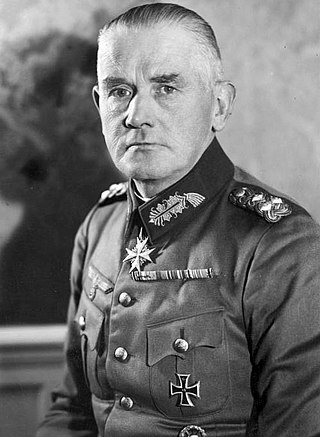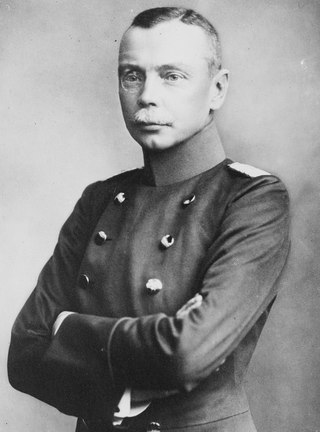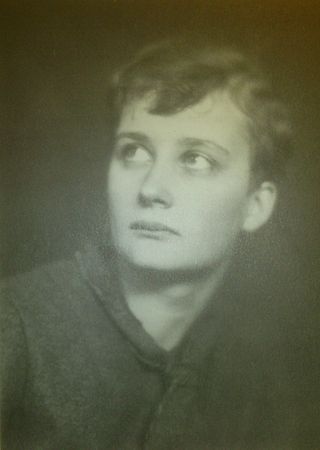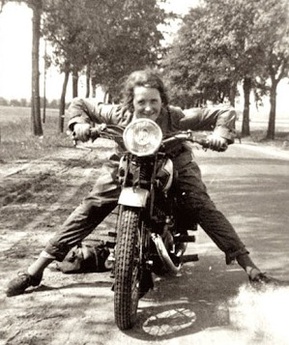
Carl von Ossietzky was a German journalist and pacifist. He was the recipient of the 1935 Nobel Peace Prize for his work in exposing the clandestine German rearmament.

Theobald Theodor Friedrich Alfred von Bethmann Hollweg was a German politician who was Chancellor of the German Empire from 1909 to 1917. He oversaw the German entry into World War I and played a key role during its first three years. He was replaced as chancellor in July of 1917 due in large part to opposition to his moderate policies by leaders in the military.

Reichswehr was the official name of the German armed forces during the Weimar Republic and the first years of the Third Reich. After Germany was defeated in World War I, the Imperial German Army was dissolved in order to be reshaped into a peacetime army. From it a provisional Reichswehr was formed in March 1919. Under the terms of the Treaty of Versailles, the rebuilt German army was subject to severe limitations in size, structure and armament. The official formation of the Reichswehr took place on 1 January 1921 after the limitations had been met. The German armed forces kept the name 'Reichswehr' until Adolf Hitler's 1935 proclamation of the "restoration of military sovereignty", at which point it became part of the new Wehrmacht.

Kurt Ferdinand Friedrich Hermann von Schleicher was a German general and the penultimate chancellor of Germany during the Weimar Republic. A rival for power with Adolf Hitler, Schleicher was murdered by Hitler's SS during the Night of the Long Knives in 1934.

Werner Eduard Fritz von Blomberg was a German General Staff officer and the first Minister of War in Adolf Hitler's government. After serving on the Western Front in World War I, Blomberg was appointed chief of the Truppenamt during the Weimar Republic. Following the Nazis' rise to power, he was named Minister of War and Commander-in-Chief of the German Armed Forces. In this capacity, Blomberg played a central role in Germany's military build-up during the years leading to World War II. However, by 20 January 1938, he was forced to resign after his rivals, Hermann Göring and Heinrich Himmler, presented Hitler with evidence that his wife had posed in the past for pornographic photos.

Johannes "Hans" Friedrich Leopold von Seeckt was a German military officer who served as Chief of Staff to August von Mackensen and was a central figure in planning the victories Mackensen achieved for Germany in the east during the First World War.

Wolfgang Kapp was a German civil servant and journalist. A strict nationalist, he is best known for being the leader of the Kapp Putsch.

Walter Simons was a German lawyer and politician. He was Foreign Minister of the Weimar Republic in 1920-21 and served as president of the Reichsgericht from 1922 to 1929.

Kurt Gebhard Adolf Philipp Freiherr von Hammerstein-Equord was a German general (Generaloberst) who was the Commander-in-Chief of the Reichswehr, the Weimar Republic's armed forces. He is regarded as "an undisguised opponent" of Adolf Hitler and the Nazi regime.
The Solf Circle was an informal gathering of German intellectuals involved in the resistance against Nazi Germany. Most members were arrested and executed after attending a tea party in Berlin on 10 September 1943 at the residence of Elisabeth von Thadden. The group's downfall also ultimately led to the demise of the Abwehr in February 1944.

The Bendlerblock is a building complex in the Tiergarten district of Berlin, Germany, located on Stauffenbergstraße. Erected in 1914 as headquarters of several Imperial German Navy offices, it served the Ministry of the Reichswehr after World War I. Significantly enlarged under Nazi rule, it was used by several departments of the Oberkommando der Wehrmacht (OKW) from 1938, especially the Oberkommando des Heeres and the Abwehr intelligence agency.
The Ebert–Groener pact, sometimes called the Ebert-Groener deal, was an agreement between the Social Democrat Friedrich Ebert, at the time the Chancellor of Germany, and Wilhelm Groener, Quartermaster General of the German Army, on November 10, 1918. This occurred on the day after the German Revolution had brought Ebert to power.

Elisabeth Adelheid Hildegard von Thadden was a German progressive educator and a resistance fighter against the Nazi régime as a member of the Solf Circle. She was sentenced to death for conspiring to commit high treason and undermining the fighting forces (Wehrkraftzersetzung).

Walther Karl Friedrich Ernst Emil Freiherr von Lüttwitz was a German general who fought in World War I. Lüttwitz is best known for being the driving force behind the Kapp–Lüttwitz Putsch of 1920 which attempted to replace the democratic government of the Weimar Republic with a military dictatorship.
Black Reichswehr was the name for the extra-legal paramilitary formations promoted by the German Reichswehr army during the time of the Weimar Republic; it was raised despite restrictions imposed by the Versailles Treaty. The secret organization was dissolved in 1923 upon the failed Küstrin Putsch.

Friedrich Rosen or Fritz Rosen was a German Orientalist, diplomat and politician. From May to October 1921 he was the Foreign Minister of Germany.
Ruth von Mayenburg was an Austrian journalist, writer and translator. In her earlier years, she was politically active in the Communist Party of Austria. Fleeing the Nazis, she lived in exile in the Soviet Union at Moscow's Hotel Lux, afterwards writing several books about her experiences there.

Marie Luise Baroness of Münchhausen, born Baroness of Hammerstein-Equord, was a German lawyer. Despite being born into an aristocratic army family she became an activist member of the Communist Party. She worked for the party's intelligence service during the 1930s. She was treated with on-going suspicion and subjected to a number of interrogations by the security services between 1933 and 1945, although her party intelligence involvement is confirmed only in a document dated 1973.

Maria Therese von Hammerstein Paasche was a German anti-Nazi activist and literary researcher. She transported Jews out of Germany in the early years of the Nazi regime and later emigrated from Nazi Germany to Japan, where she lived for several years before settling in the United States.

Walter Rossow was a leading German Landscape architect and, during his later years, a university professor. After 1945, together with leading architects of the time such as Egon Eiermann and Paul Baumgarten, Walter Rossow played a key role in reconstructing Berlin.
















